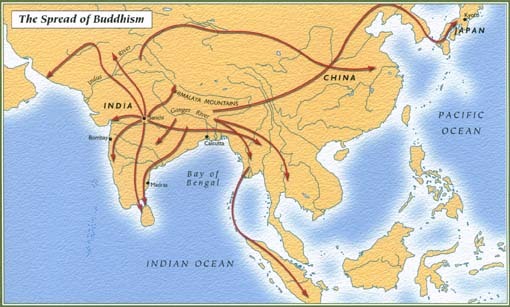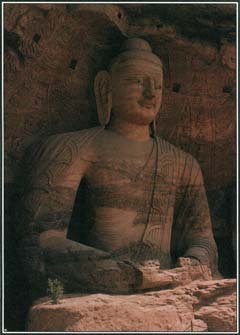Buddhism and Mythology
Buddhism, one of the great religions of the world, was founded in India in the 500s B . C . and then spread throughout Asia. Over time, many different Buddhist sects have developed, each with its own doctrines, gods, and legends. Although Buddhism has produced little mythology of its own, it has incorporated stories from mythologies of various groups that adopted the religion.
The Spread of Buddhism

Buddhist History and Teachings
The roots of Buddhism can be traced to one man: Siddhartha Gautama, a prince from a small state in northern India. Although he was a historical figure, many of the stories about him are based on legend. This has made it difficult to distinguish between fact and fiction. Yet the basic elements of Siddhartha Gautama's life story—whether real or invented—are well known, as are his religious teachings.
The Buddha. The son of King Suddhodana, Gautama was born around 563 B . C . According to legend, his mother, Queen Maya, had a dream in which she was expecting a child fathered by a white elephant. Local brahmins, or holy men, interpreted the dream to mean that the queen would give birth to a great man. They said that the child would become a powerful king unless he became aware of human suffering in the world. If that happened, he would become a great holy man and savior.
Some legends say that when Gautama was born the earth shook, rivers stopped flowing, flowers fell from the sky, and a lotus flower sprang from the place where he first touched the earth. Mindful of the prophecy about his son, King Suddhodana did everything possible to shield the boy from knowledge of the outside world and human suffering. He built a palace in which his son could enjoy all of life's pleasures, and he forbade any mention of death, grief, or sickness.
sect religious group
doctrine set of principles or beliefs ac cepted by a group
One day Gautama expressed a wish to see the world outside the palace. Suddhodana agreed to take his son to a nearby town, but

After six years of wandering and seeking wisdom from holy men, Gautama realized that he was no nearer truth and understanding than before. He decided to look for the truth within himself and went to the town of Bodh Gaya to sit beneath the Bodhi tree and meditate. While he was meditating, the evil spirit Mara tried to tempt Gautama with beautiful women. When this failed, Mara threatened him with demons and finally threw a fiery disc at him. However, the disc turned into flowers that floated down on Gautama's head.
After five weeks of meditation, Gautama came to understand that the only way to avoid suffering was to free oneself from all desires. At the moment of this revelation, Siddhartha Gautama became the Bud-the "enlightened one" who is free from suffering. He then began to travel and teach others how to achieve enlightenment. Buddha gained many followers before his death around 480 B . C .
After the death of Buddha, his followers carried Buddhist teachings throughout Asia. Within a few hundred years, Buddhism was practiced in Sri Lanka, Burma, Thailand, Cambodia, and most of Southeast Asia. By the A . D . 600S, it had spread to central Asia, China, Korea, Japan, and Tibet.
Basic Teachings. Buddhism teaches that all humans experience many lives and are constantly reincarnated—reborn after death into a different form of existence. The form each person takes in a new life depends on karma, which is the total of one's good and bad deeds in previous lives. The goal of Buddhism is to escape this cycle of death and rebirth by achieving enlightenment. When that happens, a person enters a timeless state known as nirvana and is free of all desire.
meditate to think
revelation communication of divine truth or divine will
enlightenment in Buddhism, a spiritual state marked by the absence of desire and suffering
The original form of Buddhism, recorded in texts from about 100 B . C ., is called Theravada Buddhism. Its followers believed that there would be only one Buddha in the world at any one time. Theravada Buddhism spread to Sri Lanka, Burma, and much of Southeast Asia. A later form of Buddhism, called Mahayana, taught that many Buddhas might exist at the same time. It attracted followers in China, Japan, Tibet, and Korea.
Mythology Associated with Buddhism
As Buddhism spread, it divided into many different sects. Each sect developed its own traditions and mythology, often based on a combination of local beliefs and deities with Buddhist teaching.
India. Early Buddhism in India was influenced by Brahmanism, a form of the Hindu religion. Both religions shared the idea of the cycle of birth and reincarnation, and both included Devas, traditional Indian gods, and Asuras, powerful demons.
A principal figure in Indian Buddhism was Amitabha, who was a bodhisattva—a person who had become enlightened but postponed entering nirvana in order to help others gain enlightenment. According to legend, Amitabha was born from a lotus flower and came to the aid of Buddhists who worshiped him and pronounced his sacred name.
China. Arriving in China in about A . D . 65, Buddhism developed into one of that country's three most important religions, alongside Taoism and Confucianism. Buddhist gods came to be worshiped in Taoist temples and vice versa, and in some temples, the three religions were practiced side by side.
The Mahayana Buddhism practiced in China was an elaborate form of the religion, with more gods and myths than Theravada Buddhism. In the A . D . 600S, questions arose about certain Buddhist teachings, so a monk named Xuan Zang (also called Tripitaka) went to India to obtain copies of official scriptures. An account of his legendary trip was published in the 1500s as Journey to the West. In the story, the monkey god Sun Wukong and the pig god Zhu Bajie joined Xuan Zang on his journey. During the 14-year expedition, the three travelers had to endure many ordeals and tests of their sincerity, including fighting demons and monsters with the help of a magic stick.
Chinese Buddhists established a complex hierarchy of gods and goddesses. One of the more important deities was Shang Di, whose main assistant, Dongyue Dadi, was known as Great Emperor of the Eastern Peak. Under him were various departments where the souls of virtuous people worked to manage every aspect of human and animal life.
Some of the other important Buddhist gods were the Four Kings of Heaven, the Four Kings of Hell, and the kitchen god, the most important deity of the home. Another major deity was the bodhisattva Mi-le (known in India as Maitreya), considered to be the future Buddha. Portrayed as a fat, cheerful man, Mi-Le was sometimes called the Laughing Buddha. Worshipers prayed to join him in paradise. Each district in China had its own local deity, as did all activities and ways of making a living. Even the smallest details of life were controlled by various minor gods and goddesses.
From God to Goddess
In Chinese Buddhism, the bodhisattva Avalokitesvara evolved from a male figure of sympathy into Kuanyin, the goddess of mercy. Tibetans gave Avalokitesvara's wife, Tara, the title Pandaravasin, meaning "dressed in white." The Chinese translation of that title is Pai-i-Kuanyin.
Chinese Buddhists apparently combined the figure of Tara with the characteristics of Avalokitesvara to create a mother goddess figure. As the one who blesses couples with children, Kuanyin appealed to the Chinese belief in ancestor worship, and she became one of the most popular and important Buddhist deities. In Japan, Avalokitesvara is worshiped in both male and female forms as the deity Kannon.
deity god or goddess
hierarchy organization of a group into higher and lower levels
Japan. Buddhism came to Japan in about A . D . 550 and spread quickly because of support from the Japanese royal family. Although
supporters of Shinto, the native religion of Japan, at first opposed Buddhism, the two religions eventually became closely linked. Buddhist temples contained Shinto shrines, and Shinto gods (known collectively as kamt) became Buddhist guardians. This mix of Shintoism and Buddhism continued until 1868, when the emperor declared Shinto a state religion and banned Buddhist priests and images from Shinto temples. Yet Buddhism remained popular and still has a larger following in Japan than does Shinto.
Although the various forms of Japanese Buddhism include religious ideas from India and China, they have their own mythologies and pantheons. One of the main deities is Amida (known in other Buddhist regions as Amitabha), ruler of a paradise called the Pure Land. He is worshiped by some Japanese sects as the savior of humankind. Kannon—a bodhisattva known elsewhere as Kuanyin and Avalokitesvara—is the protector of children, women in childbirth, and dead souls. Another popular deity, the bodhisattva Jizô, protects humans and rescues souls from hell. He is often described as a gentle monk who wanders through the land of the dead bringing light and comfort to the souls imprisoned there.
Tibet. Buddhism reached Tibet from India in the A . D . 600S and gradually absorbed native religious practices, creating a unique form of Buddhism. Tibetan Buddhists worship many groups of Buddhas, gods, and bodhisattvas. They also believe in the existence of numerous demons and evil spirits.
pantheon all the gods of a particular culture
ogre hideous monster

According to Tibetan Buddhists, the world goes through an endless cycle of creation and decay, and a new Buddha appears in each world age to teach Buddhist principles. Legend says that one of these Buddhas, Amitabha, ordered a bodhisattva named Avalokitesvara to bring Buddhism to Tibet. At the time, only animals and ogres lived there. Avalokitesvara thus produced a monkey and sent it to meditate in Tibet. The monkey was approached by a female ogre in the form of a beautiful woman, who offered to be his wife. The two had children, but they were covered with hair and had tails. Avalokitesvara sent the children to a forest to mate with other monkeys. He returned a year later and discovered many offspring. When Avalokitesvara gave these creatures food they turned into human beings, and he was then able to convert them to Buddhism.
See also Brahma ; Chinese Mythology ; Devils and Demons ; Flowers in Mythology ; Hinduism and Mythology ; Japanese Mythology ; Reincarnation .
Thank You